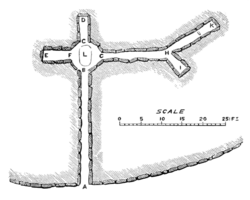now known. Still it can hardly be a mere ornament. It must be either a mason's mark, or a recognizable symbol of some sort, something to mark the position of the stone on which it is engraved, or its ownership by some person. Similar marks are found in France, but seem there equally devoid of any recognizable meaning.
The third of these great tumuli on the Boyne is known as that of Dowth. Dubhad if Petrie is right in identifying it with the third sepulchre plundered by the Danes in 862. It was dug into by a Committee of the Royal Irish Academy in 1847, but without any satisfactory results, A great gash was made in its side to its centre, which has fearfully disfigured its form,[1] but without any central chamber being reached; but on the western side a small entrance was discovered leading to a passage which extended 40 feet 6 inches (from A to D) towards the interior. At the distance of 28 feet from the entrance it formed a small domical chamber, with three branches, very like that at New Grange, but on a smaller scale. In the centre of this apartment was one large flat basin (L), similar in form, and, no doubt, in purpose, to the three at New Grange, but far larger, being 5 feet by 3 feet. The southern branch of the chamber extends to K in a curvilinear form for about 28 feet, where it is stopped for the present by a large stone, and another partially obstructs the passage at 8 feet in front of the terminal stone.
The Academy have not yet published any account of their diggings, nor does any plan of the mound exist, eo far as I know, anywhere. Even its dimensions are unknown. Pendinir these
- ↑ In extenuation of this disfigurement, it must be explained that these Irish cairns are extremely difficult to explore without destroying them. Being wholly composed of loose stones, it is almost impossible to tunnel into them, and almost as difficult to sink shafts through them. The only plan seems to be to cut into them, and, when this is done, disfigurement is inevitable.

